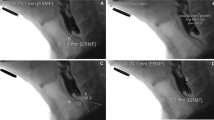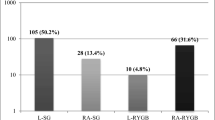Abstract
Purpose
To assess fiberoptic endoscopic evaluation of swallowing (FEES) findings in individuals with cricopharyngeal bar (CPB) and Zenker’s diverticulum (ZD).
Methods
In this retrospective chart review spanning from 2010–2018, individuals diagnosed with CPB or ZD and undergoing FEES were identified. Patient demographics, radiographic studies, and treatments were recorded, and findings were compared between CPB, ZD of < 3 cm, and ZD ≥ 3 cm.
Results
Sixty-one individuals consisting of 48 patients with ZD and 13 patients with CPB met inclusion criteria. Post-swallow hypopharyngeal reflux (PSHR) of undigested food bolus, present with or without Valsalva maneuver, was noted in 23%, 84%, and 75% of patients with CPB, ZD < 3 cm, and ZD ≥ 3 cm, respectively. The sensitivity and specificity of the finding for those with ZD were 81% and 83%, respectively. Of patients with ZD, reflux resolved in all but six individuals after surgery. Four of these patients underwent revision surgery with the reflux subsequently resolving, and two patients with persistent reflux were asymptomatic and did not desire further treatment.
Conclusions
PSHR is a good tool to identify the presence of a ZD and is less helpful to identify a CPB. Elimination of PSHR is a good tool to determine treatment success in patients with ZD and CPB.
Level of evidence
IV.



Similar content being viewed by others
References
Maran AG, Wilson JA, Al Muhanna AH (1986) Pharyngeal diverticula. Clin Otolaryngol Allied Sci 11(4):219–225
Ferreira LEVVC, Simmons DT, Baron TH (2008) Zenker’s diverticula: pathophysiology, clinical presentation, and flexible endoscopic management. Dis Esophagus 21(1):1–8. https://doi.org/10.1111/j.1442-2050.2007.00795.x
Herbella FAM, Dubecz A, Patti MG (2012) Esophageal diverticula and cancer. Dis Esophagus 25(2):153–158. https://doi.org/10.1111/j.1442-2050.2011.01226.x
Khan AS, Dwivedi RC, Sheikh Z et al (2014) Systematic review of carcinoma arising in pharyngeal diverticula: a 112-year analysis. Head Neck 36(9):1368–1375. https://doi.org/10.1002/hed.23491
Knigge MA, Thibeault SL (2018) Swallowing outcomes after cricopharyngeal myotomy: a systematic review. Head Neck 40(1):203–212. https://doi.org/10.1002/hed.24977
Anagiotos A, Preuss SF, Koebke J (2010) Morphometric and anthropometric analysis of Killian’s triangle. Laryngoscope 120(6):1082–1088. https://doi.org/10.1002/lary.20886
Richardson BE, Bastian RW (1998) Videoendoscopic swallowing study for diagnosis of Zenker’s diverticuli. Laryngoscope 108(5):721–724. https://doi.org/10.1097/00005537-199805000-00018
Bergeron JL, Long JL, Chhetri DK (2013) Dysphagia characteristics in Zenker’s diverticulum. Otolaryngol Head Neck Surg 148(2):223–228. https://doi.org/10.1177/0194599812465726
Yin T, Jardine M, Miles A et al (2018) What is a normal pharynx? A videofluoroscopic study of anatomy in older adults. Eur Arch Oto-Rhino-Laryngol 275(9):2317–2323. https://doi.org/10.1007/s00405-018-5057-6
Ongkasuwan J, Yung KC, Courey MS (2012) Pharyngeal stasis of secretions in patients with Zenker diverticulum. Otolaryngol Head Neck Surg 146(3):426–429. https://doi.org/10.1177/0194599811430048
Perie S, Dernis HP, Monceaux G et al (1999) The “sign of the rising tide” during swallowing fiberoscopy: a specific manifestation of Zenker’s diverticulum. Ann Otol Rhinol Laryngol 108(3):296–299. https://doi.org/10.1177/000348949910800314
Chen J-R, Mirghani H, Jafari A et al (2013) Role of the “rising tide sign” in the diagnosis and assessment of the results of surgery for Zenker’s diverticulum. Eur Ann Otorhinolaryngol Head Neck Dis 130(6):309–311. https://doi.org/10.1016/j.anorl.2011.11.005
Chang CY, Payyapilli RJ, Scher RL (2003) Endoscopic staple diverticulostomy for Zenker’s diverticulum: review of literature and experience in 159 consecutive cases. Laryngoscope 113(6):957–965. https://doi.org/10.1097/00005537-200306000-00009
Funding
None relevant.
Author information
Authors and Affiliations
Corresponding author
Ethics declarations
Conflict of interest
None relevant.
Ethical statement
This manuscript is in compliance with Ethical Standards and approval was obtained from University of California Irvine’s Institutional Review Board. Informed consents were acquired appropriately. The authors do not have any conflicts of interest for disclosure.
Additional information
Publisher's Note
Springer Nature remains neutral with regard to jurisdictional claims in published maps and institutional affiliations.
Rights and permissions
About this article
Cite this article
Weiland, D.J., Goshtasbi, K. & Verma, S.P. Fiberoptic endoscopic evaluation of swallowing findings in individuals with Zenker’s diverticulum and cricopharyngeal bar. Eur Arch Otorhinolaryngol 277, 2017–2021 (2020). https://doi.org/10.1007/s00405-020-05922-y
Received:
Accepted:
Published:
Issue Date:
DOI: https://doi.org/10.1007/s00405-020-05922-y




